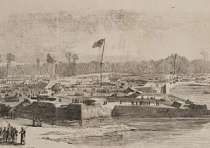
Fewer than 3,400 ill-equipped Confederate soldiers manned the fort against Grant’s 15,000 troops and Flag Officer Andrew H. Foote's seven gunboats. The Civil War in the West would be fought largely for control of the rivers.
This poorly positioned earthen field fortification was laid out on low ground by Tennessee state engineers and constructed in the summer of 1861 to defend the Tennessee River and the critical railroad route between Bowling Green, Kentucky, and Memphis. The fort became the scene of the first major Union victory in the western theater on February 6, 1862. Fewer than 3,400 ill-equipped Confederate soldiers under the command of Brigadier General Lloyd Tilghman manned the fort against Brigadier General Ulysses S. Grant’s 15,000 troops, supported by Flag Officer Andrew H. Foote's seven gunboats.
Tilghman saw the futility of his position and sent all but 70 artillerymen to reinforce nearby Fort Donelson. Foote's gunboats led the attack, and Grant's army surrounded the garrison on land. Foote and his officers simply rowed through the sally port of the half-submerged fort to receive Tilghman's "unconditional surrender," the first of the war. They found a wrecked fort and tallied Confederate losses at five dead, 11 wounded, and the remainder captive. Union forces sustained casualties of 11 killed, 31 injured, and five missing.
Within days of Fort Henry's surrender, three gunboats raided 150 miles upstream to Muscle Shoals, destroying bridges and boats and uncovering ostensible pockets of Unionist sentiment among inhabitants along the way. It was a spectacular demonstration of strategic military power. Grant soon moved his land army to besiege and capture Fort Donelson, further opening the route into Tennessee and the upper Confederate heartland.
With the fall of Fort Henry, Union forces outflanked the major Confederate defensive bastion at Columbus, Kentucky, on the Mississippi River and opened West Tennessee to Union invasion and occupation. Fort Henry demonstrated that the Civil War in the West would be fought largely for control of the rivers, commercial arteries that became wartime barriers to effective Confederate unity and Union avenues for military, political, and economic reconstruction. The site of Fort Henry now lies beneath the waters of Kentucky Lake, although outworks remain at Land Between the Lakes.
Tools
Key Facts
- Foote and his officers rowed through the sally port of the half-submerged fort to receive Tilghman's "unconditional surrender," the first of the war.
- Fort Henry now lies beneath Kentucky Lake.




